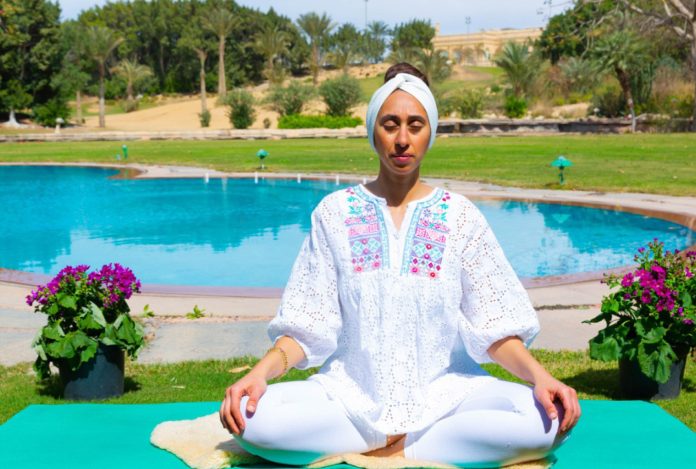Coming to Terms with the Second Na/k/b/a
By Shama Kaur, Kundalini Yoga Teacher & Wellness Mentor
As we strive to maintain normalcy in our lives, the relentless stream of breaking news from the Occupied P/a/l/e/s/t/in/i/a/n Territories is impossible to ignore. We are witnessing a second N/a/k/b/a unfolding before our eyes.
World Refugee Day this month reminds us of the need to support refugees globally, who have the right to return to their homes, receive protection and be treated justly and fairly.
Embracing yoga during turbulent times
This is especially pertinent for Palestinian refugees. According to the United Nations Relief and Works Agency for Palestinian Refugees in the Near East (UNRWA) there are over two million registered Palestinian refugees living in Jordan.
Cultivating a sense of calm, peace and spirituality becomes challenging while Palestinians continue to face persecution, massacres and humiliation, with civilians, especially women and children being targeted.
But by embracing the principles of yoga and meditation we can navigate these turbulent times with a sense of peace and mindfulness.
The horrors persist, with one massacre following another. Finding peace is difficult as Palestinians are forced into makeshift tents with poor sanitary conditions, insufficient food, inadequate healthcare and even face being burnt alive.
Sleep becomes elusive as videos of these atrocities continue to emerge, each more harrowing than the last.
Beings of light
But if we are on a spiritual path, our duty as beings of light is to never let the behaviours of others dim our own light. As the Dalai Lama says “do not let the behaviour of others destroy your inner peace.”
To become beacons of light and spread awareness of the rights of refugees worldwide, it is essential to first establish a foundation of inner peace, even amidst raging fires and the slaughter of children, inner peace is essential.
It may seem inconceivable to suggest that peace is possible at such a time, but what other choice do we have if we aspire to be spiritual healers and leaders?
Inner Peace
In yogic teachings, the sage Patanjali speaks of Santosha, the second Niyama, where “ni” means inner and “yama” means to regulate.
Niyamas are principles to guide and protect our inner world, shaping our relationship with our thoughts, feelings, words and environment.
One of those niyamas is Santosha which signifies peaceful contentment and it is an attitude that we all have the power to cultivate, akin to a muscle we can strengthen through walking or running.
Santosha (peace) echoes the meaning of words like Shanti, Sant and Islam, all of which represent peace. But to reach peace, one must first create an inner quietness that leads to a sense of serenity and tranquility.
We need to be able to find quiet in our environment and to quieten the mind so that we can experience inner peace.
But how can we do that with the buzzing of disturbing social media videos that bring shocking scenes of diabolical acts? How can one possibly sit in quiet stillness and meditate while just a few kilometres away innocent people, especially children, are being massacred?
Going inwards
When the external environment contains so much unbearable hardship, the motivation to go inwards and cultivate a state of inner peace is even greater and quite frankly, it is the only choice you have because we have greater control to change our inner world than the external world.
Another niyama that can help us navigate these challenges is Saucha which means purity of our thoughts, speech and perception of the world. It encompasses both physical cleanliness and mental clarity.
When we practice Saucha (purity), we cultivate a sense of innocence and purity that radiates through our actions and interactions. This state of purity allows us to see the world with fresh eyes, free from the distortions of negativity and impurity, fostering a deeper connection to our true selves and to the world around us.
When your body and mind is in Saucha, it becomes easier for the nervous system and the glandular system to tolerate and absorb emotional shocks and therefore, rather than reacting because the shock is too great to absorb, you are able to go inwards and become quiet and calm while processing, feeling and holding the shock.
Saucha leads to Santosha (peace). Imagine a body of lake that is free from ripples. It is calm and quiet. That is the quality that you want to cultivate in yourself regardless of what is happening in your outer world.
A calm mind
Saucha, or purity, provides the foundation for a calm mind. If our thoughts are cluttered with toxicity and delusions, our minds are not clean, making it difficult to achieve Santosha, or contentment.
Similarly, if we are angry and accusatory, our speech is neither quiet nor calm.
Choosing Santosha and practicing inner peace does not mean that we passively accept the status quo and turn a blind eye to what is happening in the word. That would be complacency, fake acceptance or resignation.
Some may even refer to this as spiritual bypassing. Santosha is also not complaining. Complaining creates a vacuum in our common condition and distracts us from effective action.
Cultivating contentment and peace
True Santosha recognises our responsibility to speak up when necessary and to remain quiet when our words only add to the noise. By avoiding complaints, we create space for conscious, deliberate actions rather than reactive patterns.
Acting without complaint allows for clarity and purpose. True Santosha is being consciously dynamic and peaceful.
When practiced consistently, even when it’s challenging, we repeatedly encourage ourselves to remain calm and focused, that is when true contentment and peace is cultivated.
As we observe World Refugee Day, let us remember the wise words of the ancient Chinese Philosopher Lao Tzu and founder of Taoism: “If there is to be peace in the world, there must be peace in the nations. If there is to be peace in the nations, there must be peace in the cities. If there is to be peace in the cities, there must be peace between neighbours. If there is to be peace between neighbours, there must be peace in the home. If there is to be peace in the home, there must be peace in the heart.”
Let us commit to working for peace and justice, first within our hearts through practicing the principles of Santosha and Saucha and then allowing that peace to vibrate out in the world.
Did You Know?
The global number of forcibly displaced people has reached over 100 million (UNHCR/2023)
You can contact Shama Kaur at [email protected]






